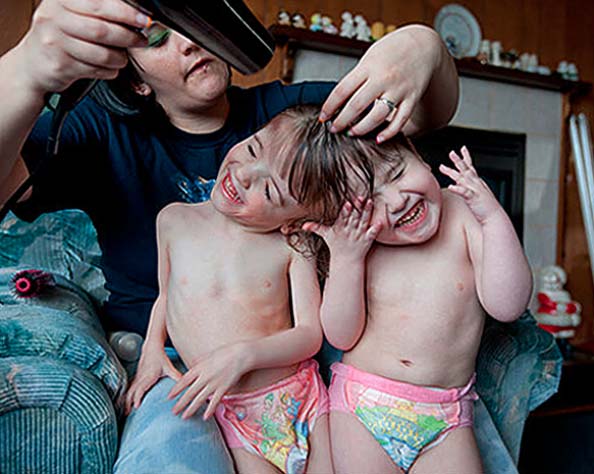 |
| Tatiana and Krista Logan/NYTimes picture |
Twins joined at the head — the medical term is craniopagus — are one in 2.5 million, of which only a fraction survive. The way the girls’ brains formed beneath the surface of their fused skulls, however, makes them beyond rare: their neural anatomy is unique, at least in the annals of recorded scientific literature. Their brain images reveal what looks like an attenuated line stretching between the two organs, a piece of anatomy their neurosurgeon, Douglas Cochrane of British Columbia Children’s Hospital, has called a thalamic bridge, because he believes it links the thalamus of one girl to the thalamus of her sister. The thalamus is a kind of switchboard, a two-lobed organ that filters most sensory input and has long been thought to be essential in the neural loops that create consciousness. Because the thalamus functions as a relay station, the girls’ doctors believe it is entirely possible that the sensory input that one girl receives could somehow cross that bridge into the brain of the other. One girl drinks, another girl feels it.Well, this gets to the question of whether a "self" exists or not, and ties in with sharing a mind, as to whether it's like pregnancy or not ... do you share a mind *all the time* with different "subminds" not shared, or do you NOT share a mind all the time?
And, then, with use of language, this raises another issue. Do you rightly call them "twins"? Of course, per Plato, that shows the problem with language at times.
I think they are twins, but it shows that consciousness is indeed based on embodied cognition, and is more than "just" the brain, though still materialist at bottom line.
But, with a hat tip to Plato's concerns about language's sometime obscurity, just how much of twins are they? Here's this:
‘I have two pieces of paper,” Krista announced. The girls sat at a small table in the living room, drawing, their faces, as always, angled away from each other. Each had one piece of paper. So I was surprised by Krista’s certainty: She had two pieces of paper? “Yeah,” the girls affirmed in their frequent singsong unison, nodding together. It was one of those moments that a neurologist or psychologist or any curious observer could spend hours contemplating. Was Krista using “I” to refer to both her and her sister? Is Tatiana agreeing with her sister’s assessment at a cognitive level or uttering the same word simultaneously for reasons unknown to her?The only thing wrong with the reporting here is that it doesn't include "philosopher" along with "neurologist" and "psychologist."
That said, it should put even my comment about "I think they are twins" under the microscope itself. Maybe they are 1.9 people? Everybody this side of Peter Singer, speaking of philosophers, might flinch at that, but, what if that is the best, albeit still rough, descrip tion?
The two themselves, or 1.9 themselves, appear to struggle a bit with the issue:
Although each girl often used “I” when she spoke, I never heard either say “we,” for all their collaboration. It was as if even they seemed confused by how to think of themselves, with the right language perhaps eluding them at this stage of development, under these unusual circumstances — or maybe not existing at all. “It’s like they are one and two people at the same time,” said Feinberg, the professor of psychiatry and neurology at Albert Einstein College of Medicine. What pronoun captures that?That said, the story is two years old. As they are now in school and interacting with more people outside the home, it would be interesting to see the personality development. And, then, wonder more about how many people there are ... 2? 1.9? 1.94?
On the one hand, such precision loops back onto Plato's complaints about language.
However, it also fits with my stance that there is no such thing as a unitary self. It's hard enough, in the light of modern cognitive science, to believe such a thing exists in a "singleton" like me; for these unique craniopagus twins, that's even more the case.
I can understand the parents' feelings:
To the family, questions about whether the girls are two or one are so absurd as to be insulting. They are “two normal little girls who happen to go through life sharing a bubble,” Simms said. The family sees their unusual neural connections as something “neat,” as Louise, the grandmother, puts it, providing fascinating moments they notice but hardly lie awake at night contemplating. Of far greater concern to them is the girls’ physical health. “Every day when I wake up and they’re still alive — that’s a good day,” Simms told me.However ... the questions aren't absurd, no matter how "protective" the parents want to be.
No comments:
Post a Comment